San Francisco Limo is a limousine service that operates in San Francisco, Burlingame, and San Jose. The company is owned by John Smith and David Jones. By year three, San Francisco Limo aims to generate $52,000 in net profit.
The transportation/limousine industry in San Francisco is highly competitive. San Francisco Limo plans to focus on niches such as airport transportation, weddings, prom nights, and "nights on the town" to minimize vehicle downtime and build a loyal customer base. However, the true niche market that San Francisco Limo will prioritize is private school student transport, sightseeing trips, and elderly transportation. These niches offer higher margins and are less sensitive to price. In the area, there are 10 private schools with 3,502 students, 25 B&Bs, and 44 hotels/motels for the sightseeing market, and 19 retirement and assisted living facilities for the elderly transportation market. These three markets have growth rates of 5% and a potential customer base of 2,000; 2,700; and 1,816 customers respectively. San Francisco Limo will also serve Burlingame and San Jose in addition to the San Francisco market, as these areas are affluent and have a significant demand for limousine services.
San Francisco Limo will adopt a conservative approach to launch its business. The company currently has three sedans, and to control costs, the office is home-based and the vehicles are stored in a rented garage. Office space is limited in the area, so the home-based approach will be maintained as long as it does not compromise customer service.
Currently, San Francisco Limo generates only $2,500 in revenue per vehicle, while the industry average is $4,614. To grow and remain profitable, San Francisco Limo needs to significantly increase its revenue per car. This below-market average is a result of a small customer base and participation in competitive niches. Over time, the customer base will expand and the company will penetrate less competitive markets, leading to a dramatic increase in revenue per car.
The success of the company relies on the management team of John and David. John has eight years of experience in the transportation industry, starting as a limo driver and later becoming the manager of a 12-car limo fleet. David has nine years of experience in logistics for a shipping company. San Francisco Limo anticipates a reasonable pace of growth, with both principals working hard across various aspects of the business. Year one revenue is projected to reach $92,000, increasing to $225,000 by year three. Net profits will be $52,000 by year three, accounting for 22.94% of sales. The company expects to achieve profitability by month six.
Objectives:
1. Increase the monthly revenue per vehicle from $2,500 to $6,250 by the end of 2001, surpassing the statistical national average of $4,614 for sedans in the limousine industry in Northern California.
– Decrease reliance on competitive airport transfer type business.
– Increase penetration of more lucrative market segments near the company’s home base.
– Find a more profitable use for the most profitable part of the CATA contract.
Mission:
San Francisco Limo aims to become the top hourly hire sedan service within a 10-mile radius of Burlingame. The company strives to serve repeat clientele who demand reliable and secure service from drivers with detailed knowledge of the area.
Keys to Success:
1. Replace fleet vehicles frequently to minimize downtime and maintain a strong company image.
2. Emphasize superior telephone skills to quickly recognize clients and foster repeat business.
3. For small limousine companies, finding a repeat clientele willing to hire car and driver for a minimum of two hours is crucial for success. While the airport transfer business is thriving, it is important to target market segments that complement this business during slower hours. It is also beneficial to focus on brand loyal market segments with longer fares of a less-hectic nature.
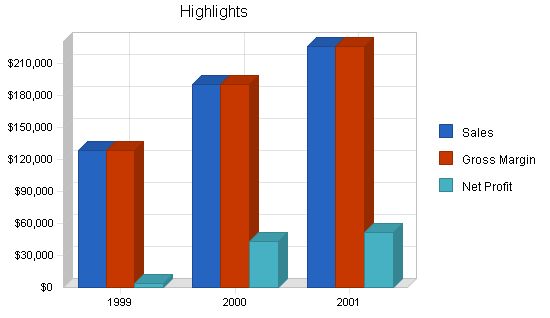
Contents
Company Summary
San Francisco Limo Incorporated is a privately-owned limousine service based in Burlingame.
Currently, there are three sedans in operation, but they have been underutilized due to a lack of marketing direction. One vehicle is primarily fulfilling a low-yielding Medicare subcontract (CATA).
The other two vehicles have struggled to capture transfer business to and from SFO Airport. While this business is attractive and steadily growing, it faces stiff competition and requires a significant amount of dead-heading. This means the vehicles often have to travel empty to pick up a fare or return after dropping off a passenger.
The constant cycle of airport pickups and drop-offs is stressful for the drivers, and the transfer business is concentrated during specific hours in the morning and late afternoon. This results in the vehicles being idle during certain slow periods each day. Consequently, it is challenging to reach the national average revenue per car of $4,615 per month.
2.1 Company History
San Francisco Limo was established in early 1997, but it initially experienced losses due to excessive hired drivers and inadequate managerial control. The stockholders’ family borrowed $26,500 to rectify the situation. The company has now resolved past mistakes and is on solid ground.
However, the monthly revenue per vehicle currently stands at around $2,500, which falls short of the Northern California Region’s national average of $4,615. These statistics are based on the 1997-98 version of Limousine & Chauffeured Transportation Fact Book, hereafter referred to as The Fact Book.
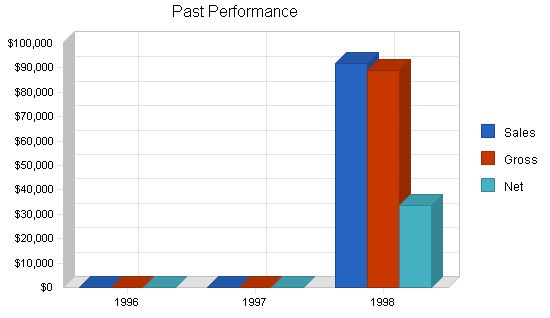
| Past Performance | |||
| 1996 | 1997 | 1998 | |
| Sales | $0 | $0 | $92,007 |
| Gross Margin | $0 | $0 | $88,898 |
| Gross Margin % | 0.00% | 0.00% | 96.62% |
| Operating Expenses | $0 | $0 | $55,141 |
| Collection Period (days) | 0 | 0 | 18 |
| Balance Sheet | |||
| 1996 | 1997 | 1998 | |
| Current Assets | |||
| Cash | $0 | $0 | $1,200 |
| Accounts Receivable | $0 | $0 | $4,000 |
| Other Current Assets | $0 | $0 | $0 |
| Total Current Assets | $0 | $0 | $5,200 |
| Long-term Assets | |||
| Long-term Assets | $0 | $0 | $14,000 |
| Accumulated Depreciation | $0 | $0 | $0 |
| Total Long-term Assets | $0 | $0 | $14,000 |
| Total Assets | $0 | $0 | $19,200 |
| Current Liabilities | |||
| Accounts Payable | $0 | $0 | $0 |
| Current Borrowing | $0 | $0 | $12,000 |
| Other Current Liabilities (interest free) | $0 | $0 | $3,500 |
| Total Current Liabilities | $0 | $0 | $15,500 |
| Long-term Liabilities | $0 | $0 | $26,500 |
| Total Liabilities | $0 | $0 | $42,000 |
| Paid-in Capital | $0 | $0 | $100 |
| Retained Earnings | $0 | $0 | ($56,657) |
| Earnings | $0 | $0 | $33,757 |
| Total Capital | $0 | $0 | ($22,800) |
| Total Capital and Liabilities | $0 | $0 | $19,200 |
| Other Inputs | |||
| Payment Days | 0 | 0 | 80 |
| Sales on Credit | $0 | $0 | $40,000 |
| Receivables Turnover | 0.00 | 0.00 | 10.00 |
2.2 Company Ownership
The company is incorporated in California by John Smith and David Jones, with equal shares held by their spouses.
2.3 Company Locations and Facilities
This is a home office in Burlingame, California. A two-car garage is also rented in San Bruno, CA. There are no other offices. To efficiently manage the fleet, the company uses a network of cell phones and shortwave communication, along with landlines.
Services
San Francisco Limo offers limousine services in the San Francisco/Burlingame/San Jose area. The company will focus on airport transfers, sightseeing services, transportation of private school students, and elderly citizens. These markets have less competition and customers who are willing to pay premium prices for premium service.
3.1 Competitive Comparison
There are 59 limousine companies advertising in the San Francisco/Burlingame/San Jose Yellow Pages directory. Of these, the most competitive segments are weddings, sightseeing, and airport transfers. The least competitive segments are private school student transportation, elderly transportation, and sightseeing.
A sampling of limousine services in the area reveals varying prices for a 4:30 a.m. pick up in Beverly to SFO:
- Rolls Royce Limo Service: $75.00
- Admiral Limo: $90.00
- Custom Coach Airport Limo: $45.00
- Dependable airport limo: $50.00
- San Francisco Limo: $45.00
- U.S. Shuttle: $22 (shared service)
3.2 Sales Literature
No sales literature or brochures are available at this time, but it is recommended to create them as part of the marketing strategy.
Market Analysis Summary
The core market for San Francisco Limo is the communities within 10 miles of Burlingame, with a total population of over 340,000. The primary sub-group within this population consists of households with annual incomes over $150,000, totaling 3,632 households. The most attractive segments for the company’s services are private school student transportation, sightseeing, and elderly transportation.
4.1 Market Segmentation
There are 59 limousine companies listed in the Burlingame/San Francisco/San Jose Yellow Pages. The majority of these companies focus on airport transfers, weddings, and parties/night-on-the-town. The segments that have received less attention are private school student transportation, elderly transportation, and sightseeing. San Francisco Limo will target these segments, which are estimated to have a potential market size of 2,000 customers for private school transportation, 2,700 customers for sightseeing services, and 1,800 customers for elderly transportation. Each of these segments is expected to grow at a rate of 5% per year.
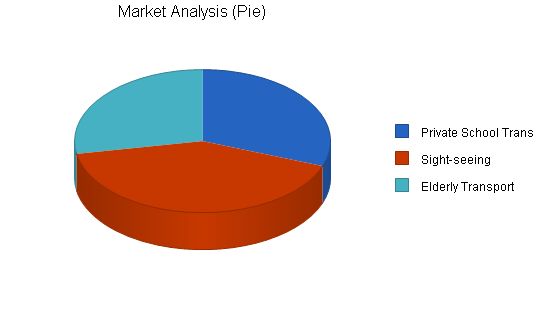
This table summarizes the growth of potential customers in the limousine service industry from 1999 to 2003:
Private School Trans: 5% growth, 2,000 in 1999 to 2,431 in 2003
Sight-seeing: 5% growth, 2,700 in 1999 to 3,282 in 2003
Elderly Transport: 5% growth, 1,816 in 1999 to 2,207 in 2003
Total: 5% growth, 6,516 in 1999 to 7,920 in 2003
4.2 Target Market Segment Strategy:
The limousine service market in the area is competitive, focusing on corporate, airport transfer, and wedding transportation. San Francisco Limo will target private schools, sightseeing, and elderly transportation segments due to low competition and less price sensitivity. By providing premium services and relying on customer referrals, the company aims to establish a reputation as a reliable service provider.
4.2.1 Market Needs:
Different customer segments have diverse needs. Corporate and airport transfer clients seek reliable and fast service, while prom and bachelor party clients prioritize social status. Wedding and funeral transportation clients value emotional benefits, and the sightseeing segment needs knowledgeable drivers who can also serve as guides.
4.3 Service Business Analysis:
Statistics from The Fact Book show that the average hourly rate for a sedan in Northern California was $39 in 1997. Revenue sources for operators include weddings (20%), airport transfers (24%), corporate clients (21.5%), night-on-the-town (15%), funeral (5%), hotel/resort (10%), and other (4.5%). San Francisco Limo aims to increase its monthly per vehicle revenue from $2,500 to match the regional average of $4,614.
4.3.1 Competition and Buying Patterns:
The private transportation services market in San Francisco is highly competitive, with various options available at different price ranges. Corporate clients prefer limousine services with large fleets, while wedding and funeral clients require stretch limousines. Airport transfer customers have lower expectations and are more price-conscious.
4.3.2 Main Competitors:
San Francisco Limo’s main competitors are Northshore Shuttle Service, Northshore Airport Limo, Dependable Airport Shuttle, Northshore Limo and Sedan Service, R and A Shuttle Service, and New England Livery. There is an opportunity for San Francisco Limo to diversify its services in the hotel/resort and "Other" segments.
Strategy and Implementation Summary:
San Francisco Limo’s sales and marketing strategy focuses on targeting the sightseeing, private school transportation, and elderly transport segments. The company will establish relationships with private schools, distribute color brochures to inns and retirement communities, and use direct mailing to target high net worth individuals.
5.1 Competitive Edge:
San Francisco Limo’s competitive edge lies in its high-quality customer service, emphasizing on-time pickups, knowledgeable drivers, and good people skills. The company aims to provide excellent customer experiences and generate positive word-of-mouth referrals.
5.2 Marketing Strategy:
A high-quality color brochure will be the key element of the marketing strategy. The brochure will showcase destination-based tours for sightseeing, transportation services for private schools, and accompaniment for elderly transportation. Brochures will be distributed to inns and sent via direct mail to wealthy households.
5.2.1 Promotion Strategy:
Aside from the brochure, San Francisco Limo will provide business cards and small limousine-shaped magnets to customers to promote brand visibility.
5.2.2 Pricing Strategy:
Pricing will be a determining factor in the sightseeing market segment. The hourly rate will be priced reasonably at $45, while rates for private school and elderly transportation may go up to $48 or $49 per hour, considering the loyalty and less price sensitivity of these segments.
5.3 Sales Strategy:
San Francisco Limo’s sales strategy will focus on building relationships with customers through excellent customer service. The company aims to understand customer needs and expand its customer base through targeted marketing efforts.
5.3.1 Sales Forecast:
The sales forecast includes projected growth in various segments, such as CATA sales, corporate clients, transfer (credit cards), and hourly hire. The company aims to increase its market share in these segments and generate steady revenue growth.
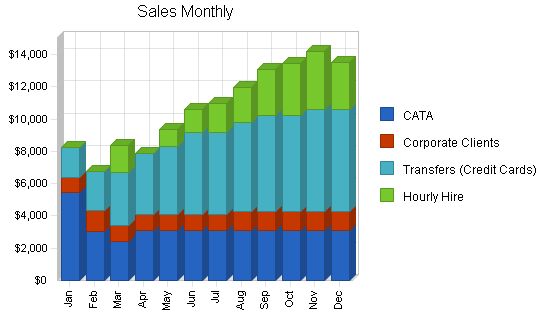
| Sales Forecast | |||
| 1999 | 2000 | 2001 | |
| Sales | |||
| CATA | $38,645 | $36,960 | $36,960 |
| Corporate Clients | $13,197 | $16,800 | $16,800 |
| Transfers (Credit Cards) | $55,866 | $86,865 | $103,680 |
| Hourly Hire | $20,697 | $49,590 | $69,120 |
| Total Sales | $128,405 | $190,215 | $226,560 |
| Direct Cost of Sales | 1999 | 2000 | 2001 |
| CATA | $0 | $0 | $0 |
| Corporate Clients | $0 | $0 | $0 |
| Transfers (Credit Cards) | $0 | $0 | $0 |
| Hourly Hire | $0 | $0 | $0 |
| Subtotal Direct Cost of Sales | $0 | $0 | $0 |
5.4 Strategic Alliances
There are currently no strategic alliances, but there may be possibilities in the future.
5.5 Milestones
The Milestones Table notes the important marketing events and their costs. Actual costs and implementation dates will be added later. The figure of $13,382 includes the down payment of $5,441 for each new vehicle, paying off the remaining balance owed on one vehicle ($12,000), and subtracting the trade-in value of the two cars (estimated at $9,500). A third vehicle (trade-in value $2,500) will be traded-in in December with a down payment of $5,441 less proceeds from trade-in.
| Milestones | |||||
| Milestone | Start Date | End Date | Budget | Manager | Department |
| Design and Produce Brochure | 5/10/1999 | 5/10/1999 | $6,500 | Peter | Marketing |
| Design Company Logo | 5/10/1999 | 5/10/1999 | $500 | Peter | Marketing |
| Trade-in Two Vehicles | 5/15/1999 | 5/15/1999 | $13,382 | Tim | Operations |
| Buy Address List/labels | 6/1/1999 | 6/1/1999 | $300 | Peter | Marketing |
| Mailing Brochures | 6/10/1999 | 6/10/1999 | $1,140 | Peter | Marketing |
| Business Plan Creation | 4/20/1999 | 4/20/1999 | $1,950 | Peter/Tim | Marketing |
| Trade-In Third Vehicle | 12/1/1999 | 12/1/1999 | $2,941 | Tim | Operations |
| Totals | $26,713 | ||||
Management Summary
The management of the company is jointly undertaken by the owners. Both owners are aware of the risks of growing too fast and are now taking a more cautious approach. Growth up to the end of 2001 will be handled by the owners themselves. The projections assume a maximum of 316 production hours per month in 1999, increasing to 390 per month in 2001. Each owner will work 160 hours per month, with the remaining hours handled by the third driver. After 2001, additional drivers and/or support staff may be considered for further growth.
6.1 Organizational Structure
The organizational structure is simple. The two owners are in constant contact and make all management and marketing decisions. One owner handles accounts in the computer, while the other handles credit card activities. Leased equipment has been obtained to facilitate credit card transactions. The third member takes instructions from both owners. Effective communication is ensured with two-meter unlimited use transmitters/receivers.
6.2 Personnel Plan
Currently, San Francisco Limo has three vehicles. Two are driven full-time by the owners and the third part-time by a relative. To meet the growing demand, the part-time driver will need to work a full 40-hour week. Based on projected sales, the following hours will be necessary:
The additional production time will be met by the hired driver working 40 hours per week. The remaining time will be handled by each owner working a maximum of 30 hours driving, with the rest dedicated to administrative and marketing tasks.
It is assumed that each owner will increase their salary, starting from December 1999 and escalating in subsequent years. The hired driver’s salary will also increase. The payroll for each year is as follows:
| Personnel Plan | |||
| 1999 | 2000 | 2001 | |
| Tim Politano | $15,200 | $28,200 | $32,800 |
| Peter Battinelli | $15,200 | $28,200 | $32,800 |
| Brian | $12,960 | $19,760 | $20,800 |
| Other | $0 | $0 | $0 |
| Total People | 3 | 3 | 3 |
| Total Payroll | $43,360 | $76,160 | $86,400 |
Financial Plan
The financial plan is to borrow $25,000 at an interest rate of 10% to finance the marketing plan and down payments on two new vehicles. Most of the cost of the new vehicles will be dealer-financed. These funds will be repaid through the increased cash flow of the company over the next two years. The $12,000 owed on one existing vehicle will also need to be repaid before trading it in.
7.1 Important Assumptions
- Short-term Interest Rate: An interest rate of 10% is assumed on the $25,000 in borrowings to be obtained in May 1999.
| General Assumptions | |||
| 1999 | 2000 | 2001 | |
| Plan Month | 1 | 2 | 3 |
| Current Interest Rate | 10.00% | 10.00% | 10.00% |
| Long-term Interest Rate | 0.90% | 0.90% | 0.90% |
| Tax Rate | 24.96% | 24.50% | 24.96% |
| Other | 0 | 0 | 0 |
7.2 Key Financial Indicators
The chart below shows past and projected benchmarks.
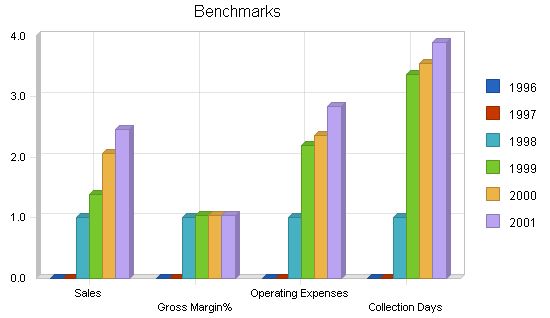
Assuming each hour San Francisco Limo hires out its services, it will collect $45 net of tolls, credit card charges, and other fees. The variable costs include fuel and oil at $2.60, and labor for the driver at $10.14 (all inclusive). The total variable cost amounts to $12.74.
For every hired hour, the company generates a net revenue of $32.26 ($45 – $12.74), which is used to cover fixed costs. These fixed costs, excluding the planned marketing expenses for 1999, amount to $4,258.
According to the Break-even Analysis, the company needs to provide 132 hours of hired service per month to reach the break-even point. This is favorable compared to the hire service capacity of 480 hours per month (40 hrs/wk for each of three cars). The break-even point would be at 141 hours if the hourly hire rate is $43, and at 121 hours if the rate is $48 per hour.
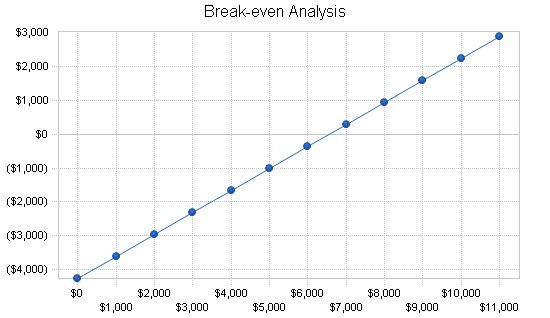
Break-even Analysis
Monthly Revenue Break-even: $6,551
Assumptions:
– Average Percent Variable Cost: 35%
– Estimated Monthly Fixed Cost: $4,258
7.4 Projected Profit and Loss
– Yellow Pages Ads: San Francisco Limo committed to quarter column ads in three local directories (#422, 540, and 584) at a monthly cost of $28, $35, and $32 respectively, as well as "one inch in-column" ads in directories #322 and #222 (Beverly, Topsfield, Danvers/San Francisco, San Jose, Danvers) at a monthly cost of $55 each. Total monthly expense is $205. These new directories are appearing in April/May 1999.
– Brochures: These brochures will primarily be delivered to B&Bs and assisted living institutions, as well as be mailed to targeted wealthy households in the area. The numbers for May reflect the $6,500 spent on these brochures. A logo needs to be designed for both the brochure and the letterhead ($500).
– Depreciation: (A) Office furniture (total $2,000 as at 12/31/98) is being depreciated over seven years. Straight line method. $23.80 per month. (B) The two new sedans planned for acquisition in May 1999 (cost $27,205 each) will have an estimated depreciated value after 18 months of $15,500 each. Depreciation for both vehicles totals $1,300 monthly. It is assumed that at the end of an 18-month period, these vehicles will be sold at the net book value and will be replaced at the same acquisition cost by two similar vehicles. At the end of 1999, the 1991 Pontiac will be sold and replaced with a new vehicle also at a cost of $27,205, which will have monthly depreciation of $650 and will be replaced in a similar manner as the other vehicles.
– Garage Rental: $200 monthly for a garage located in Lynn that serves partly as home base/office.
– Fuel: Vehicle mileage is approximately 17-18 mpg. Fuel used is 93 octane costing about $1.20 per gallon. It is assumed that to achieve every $50 of revenue a vehicle will require two gallons of fuel. In 1999, the revenue is projected at $128,405. This would amount to 5,136 gallons @ $1.20 equalling $6,163.
– Oil Changes: Oil changes are made every 3,000 miles and cost approximately $30. At 18 mpg and assuming two gallons per $50 revenue, for every $4,167 in revenue, an oil change is necessary. Repairs: The reasoning behind trading in vehicles every 18 months is to avoid downtime and expenditures in repairs. However, even new vehicles require some attention (including tires, etc). An expense of $800 per month per vehicle until the present vehicles are replaced with new ones, after which $100 per month per vehicle.
– Washing and Waxing: Assume 6 washes per month per vehicle @ $20.
– Airport Fees: An airport fee of $1.35 is charged on pickups at SFO but not on drop-offs. Assume that 90% of Transfer and Corporate Client revenue involves SFO Airport. Assume 50% of that involves a pickup.
– Dues and Subscriptions: Charges for daily newspapers supplied for clients. $660 annually.
– Registration and Transfers: $85 per vehicle every other year, and $35 on the sale of a vehicle to transfer plates.
– Excise Tax: This is set by the town at $13 per $1,000.
– Insurance: Insurance will depend on the coverage. According to John Walsh Insurance in San Francisco, they insure a livery company with five vehicles (not carrying passengers) at an annual cost of $12,000. Assume $2,000 per vehicle.
– Telephone: San Francisco Limo has an 800 number at $35/month, a cell phone from Nextel with 300 free minutes at $300 per month (.43/minute thereafter) averaging $350/month, three walkie-talkie units with unlimited usage at $40 each, and two land lines averaging $100/month. Total: $605/month. Sales activity has increased this in 2000 and 2001.
– Payroll: See the section "Payroll" for an explanation of assumptions on salaries.
– Accounting: $680 payable every four months.
– Miscellaneous: Includes postage, uniforms, office supplies, fines, and tickets, etc. Assume $100/month.
– Self-mailer Campaign: Once the brochures are ready (June), a list will be purchased (approx. $300) of the $3,600 wealthy households in the area. The cost for mailing these will be spread out over a period of six months. Mailing, including folding, sticker closing, and franking will cost about .38 each ($380 June, September, and November).
– Leased Equipment: This $55 refers to monthly rental of credit card equipment.
Pro Forma Profit and Loss
1999 2000 2001
Sales $128,405 $190,215 $226,560
Direct Cost of Sales $0 $0 $0
Other $0 $0 $0
Total Cost of Sales $0 $0 $0
Gross Margin $128,405 $190,215 $226,560
Gross Margin % 100.00% 100.00% 100.00%
Expenses
Payroll $43,360 $76,160 $86,400
Sales and Marketing and Other Expenses $50,754 $32,805 $36,087
Depreciation $10,685 $278 $11,983
Depreciation $660 $660 $660
Utilities $0 $0 $0
Insurance $6,000 $6,000 $6,000
Garage Rental $2,400 $2,400 $2,400
Accounting $2,040 $2,040 $2,040
Payroll Taxes $5,485 $9,634 $10,930
Other $0 $0 $0
Total Operating Expenses $121,384 $129,977 $156,500
Profit Before Interest and Taxes $7,021 $60,238 $70,060
EBITDA $17,706 $60,516 $82,043
Interest Expense $2,491 $2,501 $1,204
Taxes Incurred $1,080 $14,146 $17,185
Net Profit $3,450 $43,591 $51,671
Net Profit/Sales 2.69% 22.92% 22.81%
7.5 Projected Cash Flow
Capital Expenditures: The remaining $12,000 owed on the 1996 has to be repaid and the two present vehicles (the 1994 and the 1996) sold for a combined price of $9,500. To meet the cash requirements for this repayment, the company will secure a one-month $4,000 loan from its bank. This short-term loan is reflected as a corresponding increase in April’s Current Borrowing and a subsequent decrease in the same line in May. The sales transaction of the two old vehicles in the amount of $9,500 is reflected in April’s cash flow. The purchase transaction in May for each car resulted in:
– Increase in Capital Assets (vehicle): $27,205
– Increase in Long-Term Borrowing (dealer financing): $21,764
– Monthly Depreciation Provision: $650
– Monthly Repayment Loan Principal: $613.
At the end of 18 months, these cars will be sold for an estimated price of $15,500 each and two new cars (same transaction as above) will replace them. The sale transaction for each car will be:
– Decrease Capital Assets (vehicle): $27,205
– Decrease Accumulated Depreciation: $11,705
– Repay Outstanding Loan Balance: $10,730
– Increase Cash From Sale: $15,500.
The net effect of the buy/sell per car is:
– Decrease Accumulated Depreciation: $11,705
– Increase Dealer Financing Per Car: $11,034
– Increase Cash From Sale: $15,500.
In December of 1999, a 6-7 passenger van will be purchased. For the sake of simplicity of projections, we will assume the same price and financial arrangements as for the Mercury Marquis. In a similar fashion, this vehicle will also be traded in after 18 months.
Other Liabilities: Some outstanding debts remain from the start-up period, including tunnel charges (Fast Lane) amounting to $3,500. This amount is repaid in 2001 in a lump sum. There is also the matter of repayment of the $26,500 borrowed from private sources at the start of the business.
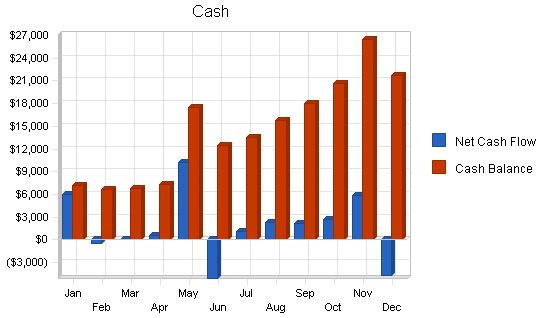
Pro Forma Cash Flow
| Pro Forma Cash Flow | |||
| 1999 | 2000 | 2001 | |
| Cash from Operations | $115,565 | $171,194 | $203,904 |
| Cash from Receivables | $14,115 | $17,709 | $21,885 |
| Subtotal Cash from Operations | $129,679 | $188,903 | $225,789 |
| Additional Cash Received | |||
| Sales Tax, VAT, HST/GST Received | $0 | $0 | $0 |
| New Current Borrowing | $21,000 | $0 | $0 |
| New Other Liabilities (interest-free) | $0 | $0 | $0 |
| New Long-term Liabilities | $64,099 | $0 | $0 |
| Sales of Other Current Assets | $0 | $0 | $0 |
| Sales of Long-term Assets | $12,000 | $0 | $0 |
| New Investment Received | $0 | $0 | $0 |
| Subtotal Cash Received | $226,778 | $188,903 | $225,789 |
Projected Balance Sheet
Except for $2,000 in office equipment at the end of 1998, capital assets represents three vehicles. The 1994 and 1996 sedans will be sold in May and replaced by two new Mercury Marquis at a book value of $27,205 each. The third vehicle (1991 Pontiac) will remain in service until the end of 1999, at which time it will be replaced by a Town and Country six to seven passenger van at an acquisition price of $27,205.
Capital assets of $12,000 (net of above equipment) represents the net book value of three vehicles which are to be traded in during 1999. This figure of $12,000 is the net amount expected to be realized at the time of the planned trade-ins. Therefore no further depreciation has been provided for these vehicles. Inventory represents uniforms purchased but not yet written off.
| Pro Forma Balance Sheet | |||
| 1999 | 2000 | 2001 | |
| Assets | |||
| Current Assets | |||
| Cash | $21,750 | $50,256 | $89,664 |
| Accounts Receivable | $2,726 | $4,038 | $4,809 |
| Other Current Assets | $0 | $0 | $0 |
| Total Current Assets | $24,475 | $54,293 | $94,473 |
| Long-term Assets | |||
| Long-term Assets | $83,615 | $83,615 | $83,615 |
| Accumulated Depreciation | $10,685 | $10,963 | $22,946 |
| Total Long-term Assets | $72,930 | $72,652 | $60,669 |
| Total Assets | $97,405 | $126,945 | $155,142 |
| Liabilities and Capital | 1999 | 2000 | 2001 |
| Current Liabilities | |||
| Accounts Payable | $4,820 | $5,769 | $6,288 |
| Current Borrowing | $25,000 | $10,000 | $0 |
| Other Current Liabilities | $3,500 | $3,500 | $0 |
| Subtotal Current Liabilities | $33,320 | $19,269 | $6,288 |
| Long-term Liabilities | $83,435 | $83,435 | $72,941 |
| Total Liabilities | $116,755 | $102,704 | $79,229 |
| Paid-in Capital | $100 | $100 | $100 |
| Retained Earnings | ($22,900) | ($19,450) | $24,142 |
| Earnings | $3,450 | $43,591 | $51,671 |
| Total Capital | ($19,350) | $24,242 | $75,913 |
| Total Liabilities and Capital | $97,405 | $126,945 | $155,142 |
| Net Worth | ($19,350) | $24,242 | $75,913 |
Business Ratios
The following table represents San Francisco Limo’s Business Ratios. Industry standards are taken from SIC code 4119, “other local transportation.”
| Ratio Analysis | |||||||||||||
| 1999 | 2000 | 2001 | Industry Profile | ||||||||||
| Sales Growth | 39.56% | 48.14% | 19.11% | 3.70% | |||||||||
| Percent of Total Assets | |||||||||||||
| Accounts Receivable | 2.80% | 3.18% | 3.10% | 16.70% | |||||||||
| Other Current Assets | 0.00% | 0.00% | 0.00% | 47.00% | |||||||||
| Total Current Assets | 25.13% | 42.77% | 60.89% | 64.90% | |||||||||
| Long-term Assets | |||||||||||||
| Long-term Assets | 74.87% | 57.23% | 39.11% | 35.10% | |||||||||
| Total Assets | 100.00% | 100.00% | 100.00% | 100.00% | |||||||||
| Current Liabilities | |||||||||||||
| Accounts Payable | 4.82% | 5.77% | 6.29% | 30.00% | |||||||||
| Current Borrowing | 25.00% | 10.00% | 0.00% | 26.20% | |||||||||
| Other Current Liabilities | 3.50% | 3.50% | 0.00% | 26.20% | |||||||||
| Subtotal Current Liabilities | 33.32% | 19.27% | 6.29% | 56.20% | |||||||||
| Long-term Liabilities | 83.44% | 83.43% | 72.94% | 26.20% | |||||||||
| Total Liabilities | 116.75% | 102.70% | 79.23% | 56.20% | |||||||||
| Net Worth | -19.35% | 24.24% | 75.91% | 43.80% | |||||||||
| Pro Forma Balance Sheet | |||||||||||||
| Jan | Feb | Mar | Apr | May | Jun | Jul | Aug | Sep | Oct | Nov | Dec | ||
| Assets | Starting Balances | ||||||||||||
| Cash | $1,200 | $7,169 | $6,666 | $6,739 | $7,312 | $17,542 | $12,431 | $13,509 | $15,747 | $17,959 | $20,625 | $26,492 | $21,750 |
| Accounts Receivable | $4,000 | $2,827 | $1,477 | $1,488 | $1,595 | $1,701 | $1,967 | $2,120 | $2,253 | $2,462 | $2,609 | $2,722 | $2,726 |
| Other Current Assets | $0 | $0 | $0 | $0 | $0 | $0 | $0 | $0 | $0 | $0 | $0 | $0 | $0 |
| Total Current Assets | $5,200 | $9,996 | $8,142 | $8,227 | $8,907 | $19,243 | $14,398 | $15,629 | $18,000 | $20,421 | $23,234 | $29,214 | $24,475 |
| Long-term Assets | |||||||||||||
| Long-term Assets | $14,000 | $14,000 | $14,000 | $14,000 | $4,500 | $58,910 | $58,910 | $58,910 | $58,910 | $58,910 | $58,910 | $56,410 | $83,615 |
| Accumulated Depreciation | $0 | $23 | $47 | $70 | $93 | $1,417 | $2,741 | $4,065 | $5,389 | $6,713 | $8,037 | $9,361 | $10,685 |
| Total Long-term Assets | $14,000 | $13,977 | $13,953 | $13,930 | $4,407 | $57,493 | $56,169 | $54,845 | $53,521 | $52,197 | $50,873 | $47,049 | $72,930 |
| Total Assets | $19,200 | $23,973 | $22,095 | $22,157 | $13,314 | $76,736 | $70,567 | $70,474 | $71,521 | $72,618 | $74,107 | $76,263 | $97,405 |
| Liabilities and Capital | Jan | Feb | Mar | Apr | May | Jun | Jul | Aug | Sep | Oct | Nov | Dec | |
| Current Liabilities | |||||||||||||
| Accounts Payable | $0 | $5,156 | $4,777 | $5,217 | $5,502 | $10,772 | $5,063 | $4,886 | $5,440 | $5,405 | $5,504 | $6,003 | $4,820 |
| Current Borrowing | $12,000 | $12,000 | $12,000 | $12,000 | $4,000 | $25,000 | $25,000 | $25,000 | $25,000 | $25,000 | $25,000 | $25,000 | $25,000 |
| Other Current Liabilities | $3,500 | $3,500 | $3,500 | $3,500 | $3,500 | $3,500 | $3,500 | $3,500 | $3,500 | $3,500 | $3,500 | $3,500 | $3,500 |
| Subtotal Current Liabilities | $15,500 | $20,656 | $20,277 | $20,717 | $13,002 | $39,272 | $33,563 | $33,386 | $33,940 | $33,905 | $34,004 | $34,503 | $33,320 |
| Long-term Liabilities | $26,500 | $26,500 | $26,500 | $26,500 | $26,500 | $70,029 | $68,835 | $67,641 | $66,447 | $65,253 | $64,059 | $62,865 | $83,435 |
| Total Liabilities | $42,000 | $47,156 | $46,777 | $47,217 | $39,502 | $109,301 | $102,398 | $101,027 | $100,387 | $99,158 | $98,063 | $97,368 | $116,755 |
| Paid-in Capital | $100 | $100 | $100 | $100 | $100 | $100 | $100 | $100 | $100 | $100 | $100 | $100 | $100 |
| Retained Earnings | ($56,657) | ($22,900) | ($22,900) | ($22,900) | ($22,900) | ($22,900) | ($22,900) | ($22,900) | ($22,900) | ($22,900) | ($22,900) | ($22,900) | ($22,900) |
| Earnings | $33,757 | ($383) | ($1,882) | ($2,260) | ($3,388) | ($9,765) | ($9,031) | ($7,753) | ($6,066) | ($3,740) | ($1,156) | $1,696 | $3,450 |
| Total Capital | ($22,800) | ($23,183) | ($24,682) | ($25,060) | ($26,188) | ($32,565) | ($31,831) | ($30,553) | ($28,866) | ($26,540) | ($23,956) | ($21,104) | ($19,350) |
| Total Liabilities and Capital | $19,200 | $23,973 | $22,095 | $22,157 | $13,314 | $76,736 | $70,567 | $70,474 | $71,521 | $72,618 | $74,107 | $76,263 | $97,405 |
| Net Worth | ($22,800) | ($23,183) | ($24,682) | ($25,060) | ($26,188) | ($32,565) | ($31,831) | ($30,553) | ($28,866) | ($26,540) | ($23,956) | ($21,104) | ($19,350) |

Business Plan Outline
- Executive Summary
- Company Summary
- Services
- Market Analysis Summary
- Strategy and Implementation Summary
- Management Summary
- Financial Plan
- Appendix
“>
Hello!
I’m Andrew Brooks, a seasoned finance consultant from the USA and the mind behind phonenumber247.com.
My career is built on a foundation of helping individuals and businesses thrive financially in an ever-changing economic landscape. At phonenumber247.com, my aim is to demystify the complex world of finance, providing clear, actionable advice that can help you navigate your financial journey with confidence. Whether it’s personal finance management, investment strategies, or understanding the nuances of market dynamics, I’m here to share insights and tools that can propel you towards your financial goals.
Welcome to my digital space, where every piece of advice is a step closer to financial clarity and success!
